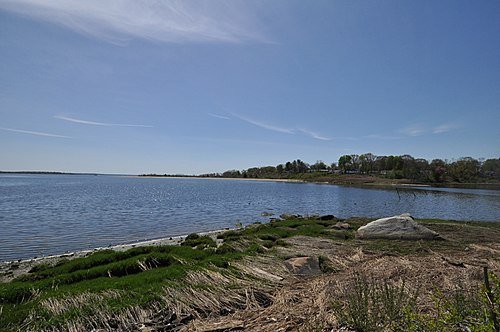
John S. Long: June walks on Gaspee Point
View of Gaspee Point from the north. Taken from across Passeonkquis Cove.
—Photo by Magicpiano
June 3, 2023
I’m walking on Gaspee Point, in Warwick, R.I., again. The wind is out of the northeast at a steady 16 mph, and it feels 10 degrees cooler. I see an Osprey atop its nest, but to my distress the nest seems otherwise unoccupied following days of unrelenting rain. Tomorrow is a full moon (a Strawberry Moon), and the tide is quite low. Gray clouds and a slate-gray Narragansett Bay stretch out, southeast, toward Colt State Park, in Bristol. Wind is whooshing through the trees. Otherwise, there’s silence except for a weed whacker sounding off above me on Gaspee Point’s high banks.
Only a handful of walkers are on the beach and the breakwater today. Iterations of waves intrude on the silence. Rain recommences, and I recall (from several weeks ago) a great cacophonous raft of Brant Geese set to embark on their stunning 2,500-mile migration to Greenland’s north coast nesting areas.
There are many seaside thickets, and pink, red and white beach roses bloom far back from high tide. Wind-driven drizzle comes, but I’m sheltered by a grove of American Elderberry trees.
There’s new sand in perfect smoothness--a beach nearly without human tracks.
June 10, 2023
I can hear a pair of Ospreys (cheereek, cheereek) on their nesting platform. Briefly, I think I’m seeing the female Osprey’s head as it pops up from the nest. Immediately, I’m wondering if there are baby Ospreys in the nest, even though it has been an cold fledgling season.
Now it’s high tide, and the wind’s from the southeast. Earlier this afternoon we had a passing shower.
Six Cormorants are resting and drying their wings on a broken erratic boulder 200 feet offshore. In winter water freezes within the boulder’s numerous cracks and pries it open oh so slowly.
A swath of the eastern sky is a robin’s egg blue with puffy clouds drifting in from the southeast.
On a shoal, edging the shipping channel, three quarters of a mile from shore is what had been Bullock Point Lighthouse--but only its granite pier remains. In my mind’s eye images of a Victorian gabled structure (1872) continue to fascinate me.
Walking north up the beach I note that one of the Ospreys (probably the male), with its wings nearly six feet across, brings new nesting branches clutched in his talons in a wide loop toward the nesting platform. A successful new family of Ospreys?
John S. Long lives in Warwick.
John S. Long: On a chilly beach, I see my first ospreys of 2023
An osprey, a great fish eater
I walked along Gaspee Point,* in Warwick, R.I., late this morning. The ospreys, in my first sighting this year, are back, and they are rebuilding their platform nest. It looked as if the male was bringing some small branches, clasped in his talons, toward the nest (perched high on a telephone pole). He hovered in the northwest wind and then dropped down onto the nesting platform.
I walked to Occupessatuxet Cove, toward the nearly submerged Greene Island, which was 14 acres before the 1938 Hurricane. Now, it’s almost gone. The chilly wind was about 15 mph, and the bay was shimmering gold as cat's paws swept across its surface. I could see Mt. Hope Bridge, connecting Bristol and Portsmouth, about 10 miles to the southeast. There seemed to be no marine traffic today as fluffy clouds drifted toward Bristol and Middletown. There's a 270-degree view from the High Banks at Gaspee Point. I gazed at the shades of ultramarine and indigo that uncoiled toward the shipping channel.
*A concave beach perhaps a mile long from north to south on the west side of Narragansett Bay; it’s famous for the burning of the burning of the HMS Gaspee, in 1772. For readers not familiar with Narragansett Bay, the point is bounded on the north by Passeonkquis Cove and on the south by Occupessatuxet Cove, and it’s reached via Namquid Drive in Warwick.
On Gaspee Point


